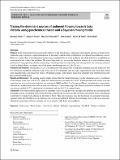| dc.description.abstract | Purpose Lake Victoria has been increasingly silting over the past decades, impacting water quality and loss of biodiversity.
Sediment control strategies require information on the relative and absolute contributions of sediment from different sources.
However, to date, there is no continuous monitoring of sediment flux or water quality in any of the tributaries, prohibiting an
assessment of the scale of the problem. The aim of this study was to trace the dominant sources of riverine sediment using
geochemical fingerprinting, thereby generating a knowledge base for improving land management and reducing sediment
yields in Simiyu River catchment, one of the main contributing rivers to Lake Victoria.
Materials and methods Geochemical tracer concentrations were analyzed in transported sediment from the main river and
two tributaries (riverbed sediments) and from soils in five dominant land use types (agricultural land, bush land, forest
land, channel banks, and main river banks). Dominant sources to the Simiyu main river sediment were attributed using the
Bayesian MixSIAR model.
Results and discussion The mixing model outputs showed that the Simiyu tributary was the dominant source of sediment
to the Simiyu main river with 63.2%, while the Duma tributary accounted for 36.8%. Cultivated land was shown to be the
main land use source of riverine sediment, accounting for 80.0% and 86.4% in Simiyu and Duma sub-tributaries, respectively,
followed by channel banks with 9.0% in both sub-tributaries. Direct unmixing of the Simiyu main river sediment to the land
use sources yielded 64.7% contribution of cultivated land and 26.5% of channel banks.
Conclusion The demonstrated application of sediment source tracing provides an important pathway for quantifying the
dominant sources of sediment in the rivers flowing towards Lake Victoria. Eroded soil from agricultural areas is the biggest
contributor to transported sediment in the Simiyu River. This information is vital for the design of catchment wide man agement plans that should focus on reducing soil erosion and sediment delivery from farming areas to the river networks,
ultimately supporting both food security and water quality in the Lake Victoria Basin. | en_US |

